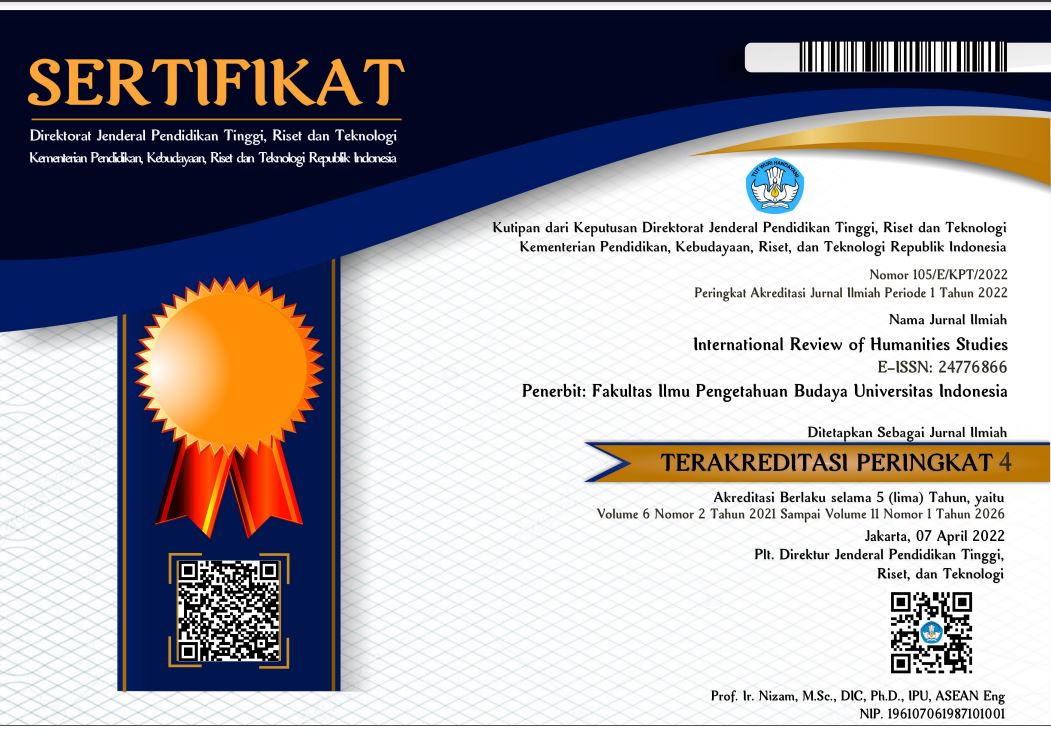International Review of Humanities Studies

Abstract
Larousse is one of the most important and widely used French-language dictionaries. Larousse dictionary annually releases its new edition with the addition of on average 150 new words due to the appearance of new words, known as the phenomenon of neologism. The aim of this study is to identify how new words or neologisms in the Larousse dictionary edition of 2018 and 2019 were formed using a morphological approach. The analysis essentially uses the combination of theories of Lehmann & Martin-Berthet (1999) and Grevisse, M., & Goosse, A. (2007) on four types of word formation: derivation, composition, siglaison (acronym), and troncation (clipping). Neologisms are often influenced by foreign languages, therefore additional theory on borrowing words from other languages and lending factors introduced by Haspelmath & Tadmor (2009) is also used. Data was collected from Larousse dictionary’s digital press kit, served to promote their latest edition, and contains the new words added in the dictionary. The study indicates that the new words in the Larousse edition of 2018 and 2019 can be categorized into two groups: (1) the first group of neologisms that are formed by the process of word-formation and (2) the neologisms that are formed through loan words. Composition dominates the process of neologisms, followed by derivation. This relates to the difficulty of composition’s formation that is considered less complicated in terms of grammar compared with derivation. Then, clipping is only found in the second group of new words. An interesting finding is that based on data analysis there is a type of word formation with nom propre (proper noun) as a base word which has not been discussed by Lehmann & Martin-Berthet or Grevisse in their theory.
References
AFP, (2018), Les mots nouveaux du Larousse et du Robert: «démocrature», «rageux», «vlog» (vidéo). [Online] Available: https://www.lesoir.be/156642/article/2018-05-14/les-mots-nouveaux-du-larousse-et-du-robert-democrature-rageux-vlog-video (March 9, 2019).
Aldash et al. (2019). Neologisms In Online Dictionaries As A Reflection Of Social Changes And Formation Of The Social Structure Of Society. International Journal Of Scientific & Technology Research, Vol. 8, Issue 12, December 2019, pp. 1432-1435.
B, Lorraine, (2017), A Brief History of the GIF, From Early Internet Innovation to Ubiquitous Relic. [Online] Available: https://www.smithsonianmag.com/history/brief-history-gif-early-internet-innovation-ubiquitous-relic-180963543/ (March 3, 2019).
Bauer, L., & Renouf, A. (2001). A Corpus-Based Study of Compounding in English. Journal of English linguistics, 29(2), 101–123. https://doi.org/10.1177/00754240122005251.
Britannica, T. E. (2019), Pierre Larousse. [Online] Available: https://www.britannica.com/biography/Pierre-Larousse (May 9, 2019).
Camarans, Christophe, (2018), «Dégagisme», «teriyaki» et «rageux» parmi les 150 nouveaux
mots du dictionnaire. [Online] Available: http://www.rfi.fr/hebdo/20180518-nouveaux-mots-entree-dictionnaire-larousse-robert-langue-francaise-neologisme (February 13, 2019).
Definitions, Meanings, Synonyms, and Grammar by Oxford Dictionary. [Online] Available: https://www.lexico.com (June 19, 2020).
Delahunty, Gerald P., & Garvey, James J, (2010), The English Language: From Sound to Sense. Perspectives on Writing. Fort Collins, Colorado: The WAC Clearinghouse and Parlor Press.
Gallix, Andrew, (2013), The French Protect Their Language like The British Protect their Currency. [Online] Available
https://www.theguardian.com/commentisfree/2013/may/23/language-french-identity (June 21, 2020).
Grevisse, M., & Goosse, A, (2007), Le bon usage: Grammaire française, Paris: Duculot.
Haspelmath, M., & Tadmor, U, (2009), Loanwords in the Worlds Languages: A Comparative Handbook, Berlin: De Gruyter Mouton
Kentjono, Djoko, (2002), Dasar-dasar Linguistik Umum, Depok: Fakultas Sastra, Universitas Indonesia.
Kridalaksana, Harimurti, (2009), Kamus Linguistik (Edisi Keempat,. Jakarta: Gramedia.
Larousse, É, (nd), Dictionnaire français - Dictionnaires Larousse français monolingue et bilingues en ligne. [Online] Available: https://www.larousse.fr/dictionnaires/francais.
Lefer, M. (2010). Word-formation in English-French bilingual dictionaries: the contribution of
bilingual corpora.
Lehmann, A, F. Martin-Berthet, (1999), Introduction à la lexicologie: sémantique et morphologie, Paris: Dunod.
Mouzaia, Siham.,& Mouloudji, Faiza. (2017). Composition et Dérivation Suffixale dans La Creation Néologique du Français Journalistique Algérienne: Le Cas du Journal Le Quotidien d’Oran. (Tesis, Université Abderrahmane Mira, Aljazair). http://www.univ-bejaia.dz/jspui/handle/123456789/9736. Diakses pada 13 Februari 2019.
Sujarni, Atmi. (2014). Neologisme dalam Rubrik Signé Wolinski Di Majalah Paris Match. Skripsi, Universitas Negeri Yogyakarta. Dari https://eprints.uny.ac.id/20019/1/Atmi%20Sujarni%2008204244012.pdf diakses pada 14 Feb 2019.
Walliman, Nicholas, (2011), Research Metodhes: The Basics, London: Taylor & Francis Ltd.
Zohary D, Hopf M, Weiss E, (2012), Domestication of plants in the Old World, 4th edn. Oxford University Press, Oxford.
Recommended Citation
Julisdianti, Amelia Wahyu and Susanto, Danny
(2021)
"FRENCH NEOLOGISMS IN LAROUSSE DICTIONARY OF 2018 AND 2019,"
International Review of Humanities Studies: Vol. 6:
No.
3, Article 2.
DOI: 10.7454/irhs.v6i3.1329
Available at:
https://scholarhub.ui.ac.id/irhs/vol6/iss3/2
Included in
Anthropology Commons, Art and Design Commons, Creative Writing Commons, Cultural Heritage Law Commons, Education Law Commons, Film and Media Studies Commons, History Commons, Intellectual Property Law Commons, International and Area Studies Commons, Legal Writing and Research Commons, Linguistics Commons, Museum Studies Commons, Philosophy Commons, Urban Studies and Planning Commons



